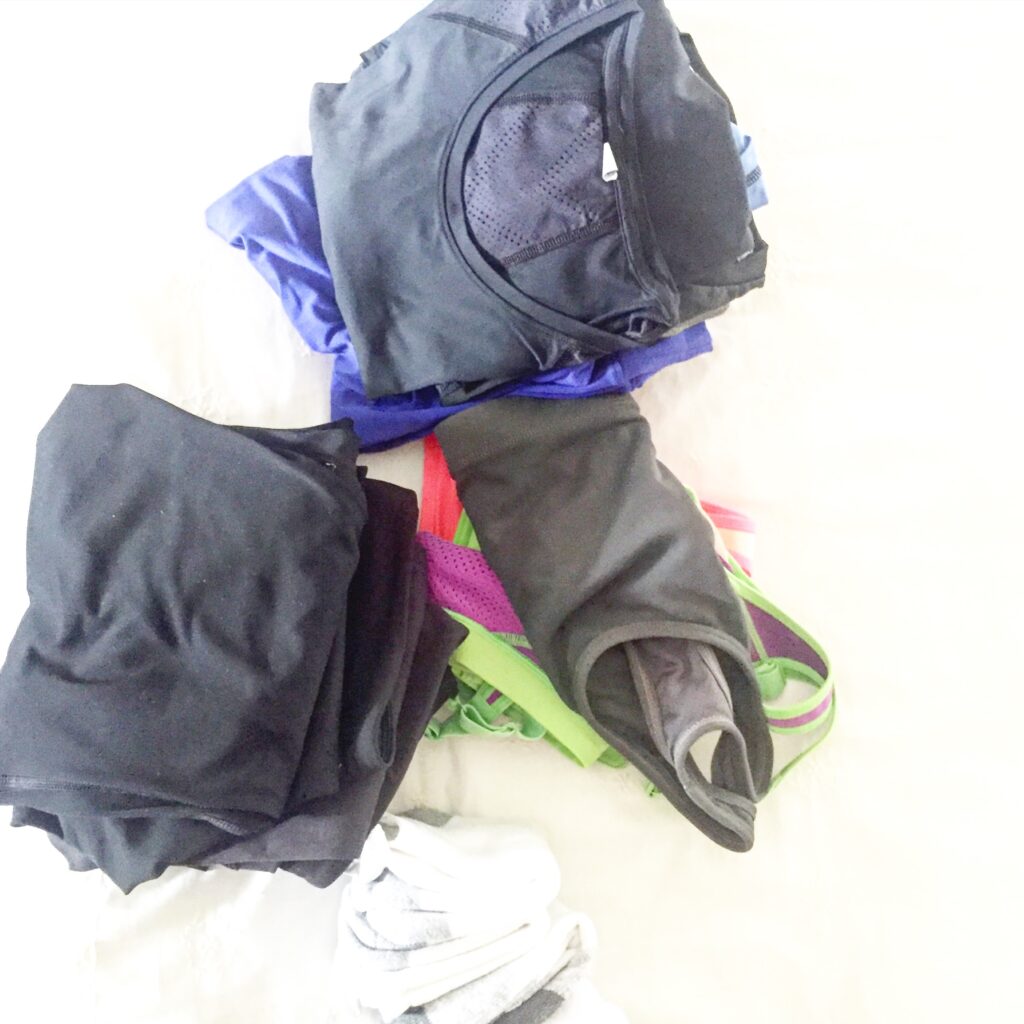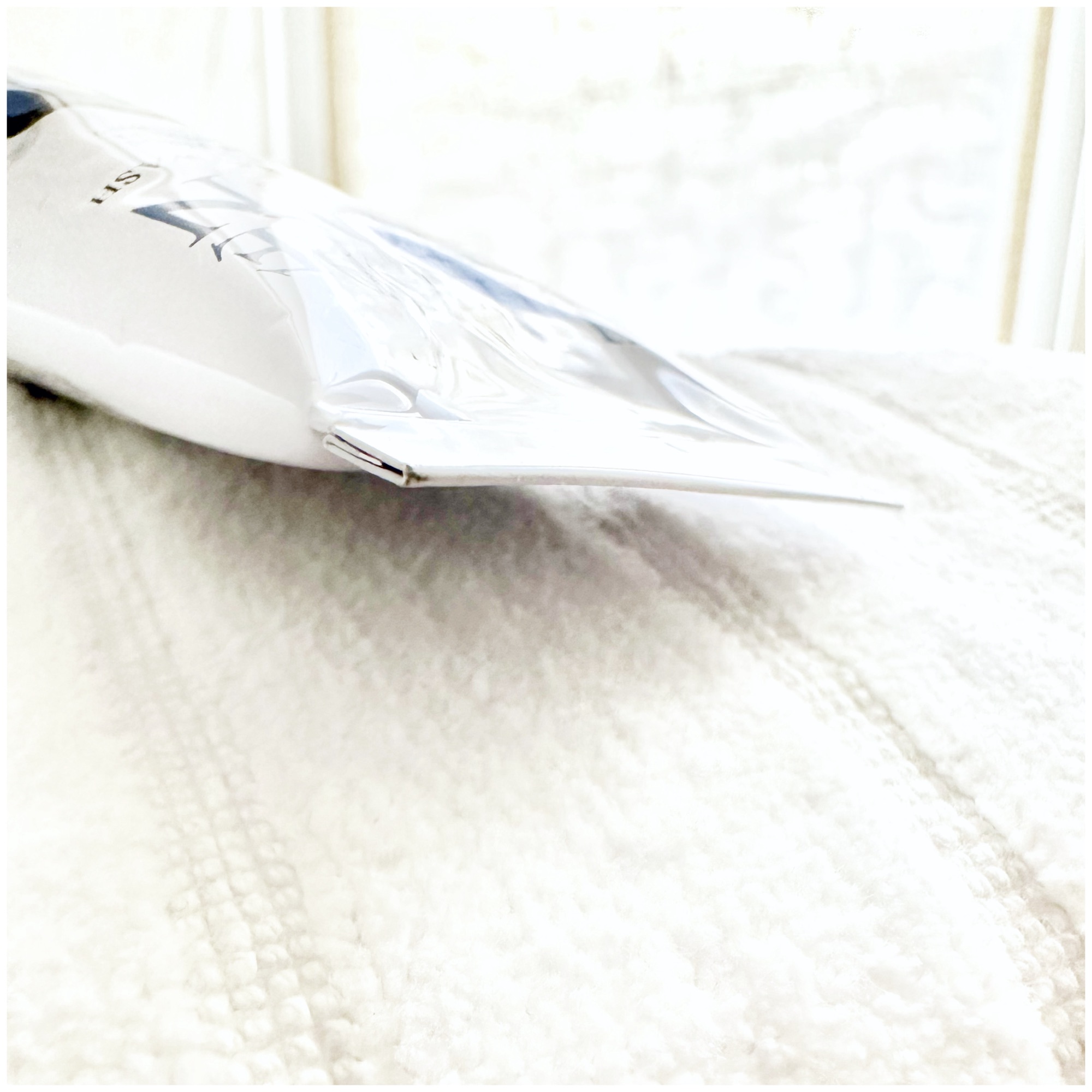Allergen
Athletic or Sports Apparel
Workout clothes won’t be in published lists of top contact allergens and they wouldn’t be in a standard patch test tray (a bit more on this below) but most sporting clothes are made up of lots of top contact allergens. Scroll to the bottom to learn how you can work out more safely if you’ve got allergic or sensitive skin, acne, or melasma.
Allergens can cause an allergic or irritant reaction (rashes, itching, redness, dryness, cracking, etc.). While clothing wouldn’t clog pores the way comedogens do, allergens and irritants (or just friction) can irritate pores, causing inflammation and acne. And any inflammation can lead to skin darkening (post-inflammatory hyperpigmentation).
There are specific patch test trays that include common clothing and textiles allergens. If your dermatologist suspects that your skin problems might be caused by by apparel (or bedsheets, towels, a headscarf, underwear, etc.) they may ask for this expanded tray for your patch testing. Because clothing contact dermatitis is a thing.
Some common allergens in athletic apparel:
- Stretch: elastic in socks, shirts, yoga pants, compression gear is a minefield. Where there’s elastic, there’s frequently also latex, rubber, thiuram and carba mix.
- Lots of workout clothes are black or dark blue, which would probably mean the presence of PPD and disperse blue. Brightly-colored hues would tend to have dyes.
- More modern sporting apparel is made of synthetic fabrics. Dyes and colorants tend to bind to natural materials better. Synthetic fabrics may contain mordants, metal-related substances that get the pigments to stick better.
- Many clothing manufacturers now tend to use formaldehyde as a preservative to keep the clothes as looking newer, longer.
Some options to keep your skin safer in workout clothes
- Get a patch test FIRST. There’s no point in stressing yourself out with clothing selection. You might be able to use lots more than you think (and you might be using “natural” or “safer” stuff that you actually need to avoid!) And, you might not be allergic to the materials in the gym themselves but ingredients in disinfectants or soaps used to clean them. A patch test saves you lots of time and error and anxiety.
- Try to use clothes in natural cotton (especially are organic, uncolored, and untreated) as much as possible. Cottonique sells great options.
- Synthetic fabrics also don’t tend to breathe as well as natural fabrics. This can be a problem if your’e dealing with and sweat “acne,” which is actual Malassezia folliculitis (a fungal condition). Fungi love humid conditions and this particular fungus loves sweat. More breathable clothing (plus changing frequently during tough workouts and immediately after) can help.
- Antimicrobial: or Kid Gloves (use either as a hand sanitizer, to wipe down gear or surfaces before you use them, and on your face and body skin to control sweat and sweat “acne.”) Bring a Boo-Boo Balm to quickly address nicks and abrasions, too.
- If you do tend to have fungal issues on the face, body, or feet, apply Id Monolaurin Gel followed by Essence Antiperspirant or Stay Fresh-ener (in the USA) before putting on socks and shoes.
- If you have bumps on the face, back, chest, arms, buttocks, thighs, etc., add Id Monolaurin Gel to your Id or SuperSkin Care regimen.
- Wash your clothing in a hypoallergenic laundry soap or hypoallergenic shampoo like Fawn & Launder or even one of our hair and body shampoos.
Subscribe to VMVinSKIN.com and our YouTube channel for more hypoallergenic tips and helpful “skinformation”!
If you have a history of sensitive skin…
…don’t guess! Random trial and error can cause more damage. Ask your dermatologist about a patch test.
To shop our selection of hypoallergenic products, visit vmvhypoallergenics.com. Need help? Ask us in the comments section below, or for more privacy (such as when asking us to customize recommendations for you based on your patch test results) contact us by email, or drop us a private message on Facebook.
For more:
- On the prevalence of skin allergies, see Skin Allergies Are More Common Than Ever.
- For the difference between irritant and allergic reactions, see It’s Complicated: Allergic Versus Irritant Reaction.
- For the difference between food, skin, and other types of reactions: see Skin & Food Allergies Are Not The Same Thing.
- On the differences between hypoallergenic, natural, and organic, check out Is Natural Hypoallergenic? and this video in our YouTube channel.
- To learn about the VH-Rating System and hypoallergenicity: What Is The Validated Hypoallergenic Rating System?
Main References:
Regularly published reports on the most common allergens by the North American Contact Dermatitis Group and European Surveillance System on Contact Allergies (based on over 28,000 patch test results, combined), plus other studies. Remember, we are all individuals — just because an ingredient is not on the most common allergen lists does not mean you cannot be sensitive to it, or that it will not become an allergen. These references, being based on so many patch test results, are a good basis but it is always best to get a patch test yourself.
- DeKoven JG, Silverberg JI, Warshaw EM, Atwater AR, et al. North American Contact Dermatitis Group Patch Test Results: 2017-2018. Dermatitis. 2021 Mar-Apr 01;32(2):111-123.
- DeKoven JG, Warshaw EM, Zug KA, et al. North American Contact Dermatitis Group Patch Test Results: 2015-2016. Dermatitis. 2018 Nov/Dec;29(6):297-309.
- DeKoven JG, Warshaw EM, Belsito DV, et al. North American Contact Dermatitis Group Patch Test Results 2013-2014. Dermatitis. 2017 Jan/Feb;28(1):33-46.
- Warshaw, E.M., Maibach, H.I., Taylor, J.S., et al. North American contact dermatitis group patch test results: 2011-2012. Dermatitis. 2015; 26: 49-59.
- W Uter et al. The European Baseline Series in 10 European Countries, 2005/2006–Results of the European Surveillance System on Contact Allergies (ESSCA). Contact Dermatitis 61 (1), 31-38.7 2009.
- Wetter, DA et al. Results of patch testing to personal care product allergens in a standard series and a supplemental cosmetic series: An analysis of 945 patients from the Mayo Clinic Contact Dermatitis Group, 2000-2007. J Am Acad Dermatol. 2010 Nov;63(5):789-98.
- Warshaw EM, Buonomo M, DeKoven JG, et al. Importance of Supplemental Patch Testing Beyond a Screening Series for Patients With Dermatitis: The North American Contact Dermatitis Group Experience. JAMA Dermatol. 2021 Dec 1;157(12):1456-1465.
- Verallo-Rowell VM. The validated hypoallergenic cosmetics rating system: its 30-year evolution and effect on the prevalence of cosmetic reactions. Dermatitis 2011 Apr; 22(2):80-97.
- Ruby Pawankar et al. World Health Organization. White Book on Allergy 2011-2012 Executive Summary.
- Misery L et al. Sensitive skin in the American population: prevalence, clinical data, and role of the dermatologist. Int J Dermatol. 2011 Aug;50(8):961-7.
- Warshaw EM1, Maibach HI, Taylor JS, Sasseville D, DeKoven JG, Zirwas MJ, Fransway AF, Mathias CG, Zug KA, DeLeo VA, Fowler JF Jr, Marks JG, Pratt MD, Storrs FJ, Belsito DV. North American contact dermatitis group patch test results: 2011-2012.Dermatitis. 2015 Jan-Feb;26(1):49-59.
- Warshaw, E et al. Allergic patch test reactions associated with cosmetics: Retrospective analysis of cross-sectional data from the North American Contact Dermatitis Group, 2001-2004. J AmAcadDermatol 2009;60:23-38.
- Foliaki S et al. Antibiotic use in infancy and symptoms of asthma, rhinoconjunctivitis, and eczema in children 6 and 7 years old: International Study of Asthma and Allergies in Childhood Phase III. J Allergy Clin Immunol. 2009 Nov;124(5):982-9.
- Kei EF et al. Role of the gut microbiota in defining human health. Expert Rev Anti Infect Ther. 2010 Apr; 8(4): 435–454.
- Thavagnanam S et al. A meta-analysis of the association between Caesarean section and childhood asthma. Clin Exp Allergy. 2008;38(4):629–633.
- Marks JG, Belsito DV, DeLeo VA, et al. North American Contact Dermatitis Group patch-test results, 1998 to 2000. Am J Contact Dermat. 2003;14(2):59-62.
- Warshaw EM, Belsito DV, Taylor JS, et al. North American Contact Dermatitis Group patch test results: 2009 to 2010. Dermatitis. 2013;24(2):50-99.
- Verallo-Rowell V. M, Katalbas S.S. & Pangasinan J. P. Natural (Mineral, Vegetable, Coconut, Essential) Oils and Contact Dermatitis. Curr Allergy Asthma Rep 16,51 (2016) . https://doi.org/10.1007/s11882-016-0630-9.
- Park G, Oh DS, Lee MG, Lee CE, Kim YU. 6-Shogaol, an active compound of ginger, alleviates allergic dermatitis-like skin lesions via cytokine inhibition by activating the Nrf2 pathway. Toxicol Appl Pharmacol. 2016 Nov 1;310:51-59. doi: 10.1016/j.taap.2016.08.019. Epub 2016 Aug 22. PMID: 27562088.
- de Groot AC. Monographs in Contact Allergy, Volume II – Fragrances and Essential Oils. Boca Raton, FL: CRC Press Taylor & Francis Group; 2019.
- De Groot AC. Monographs in Contact Allergy Volume I. Non-Fragrance Allergens in Cosmetics (Part I and Part 2). Boca Raton, Fl, USA: CRC Press Taylor and Francis Group, 2018.
- Zhu TH, Suresh R, Warshaw E, et al. The Medical Necessity of Comprehensive Patch Testing. Dermatitis. 2018 May/Jun;29(3):107-111.
Want more great information on contact dermatitis? Check out the American Contact Dermatitis Society, Dermnet New Zealand, the Contact Dermatitis Institute, and your country’s contact dermatitis association.

Laura is our “dew”-good CEO at VMV Hypoallergenics and eldest daughter of VMV’s founding dermatologist-dermatopathologist. She has two children, Madison and Gavin, and works at VMV with her sister CC and husband Juan Pablo (Madison and Gavin frequently volunteer their “usage testing” services). In addition to saving the world’s skin, Laura is passionate about health, inclusion, cultural theory, human rights, happiness, and spreading (like a VMV cream!) goodness!







